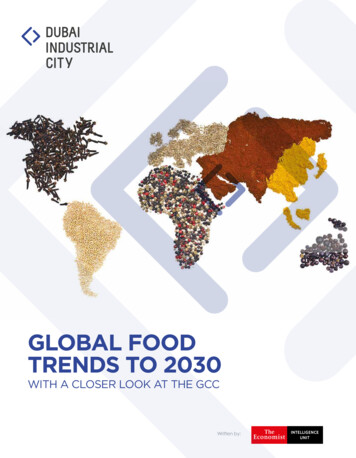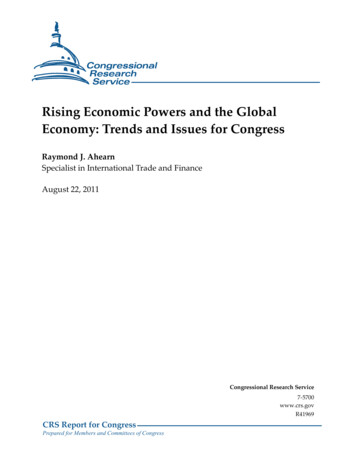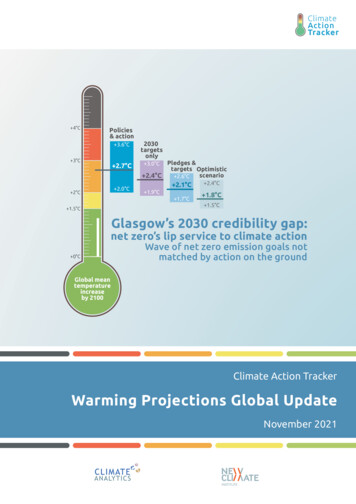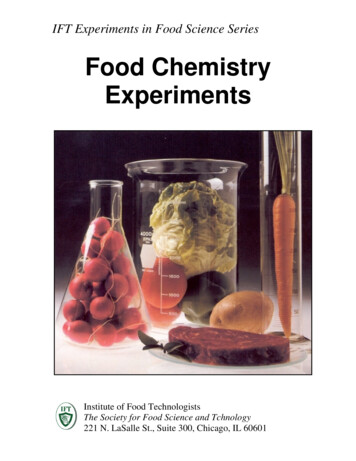
Transcription
GLOBAL FOODTRENDS TO 2030WITH A CLOSER LOOK AT THE GCCWritten by:
Global food trends to 2030: With a closer look at the GCCTable of contentsAbout this research3Executive summary4Chapter 1: Socio-economic trends that impact food systems6Chapter 2: Scientific and technological trends thatimpact food production and distribution12Chapter 3: A closer look at the GCC20Conclusion262
About this researchGlobal food trends to 2030: With a closer look atthe GCC is a Dubai Industrial City report written byThe Economist Intelligence Unit (EIU). In this paper,The EIU presents key trends that are shaping theglobal food industry landscape, focusing on foodproduction and the supply chain, followed by acloser look at those relevant to the Gulf Co-operationCouncil (GCC) countries. L awrence Goodridge, associate professor,Food Safety and Quality Program,McGill University, CanadaWe have identified these trends through an extensiveliterature review combined with in-depth interviewswith food experts, comprising academics andexecutives at food companies from around theworld—and specifically the GCC. A framework wasdeveloped to identify high-priority trends, based onthe following considerations: D anielle Nierenberg, president and founder,Food Tank, USA esponse: Is the trend a response to challengesR(e.g. food security, ecological damage healthand nutrition) or opportunities (e.g.emergingtechnologies)?Breadth: Does the trend affect multiple food typesor a broad share of the food that we consume? D ato’ Joel Low, chief executive officer,Agrivo International S antanu Mukherjee, head of digital marketing,Indusnet T amika Sims, director, food technologiescommunications, International Food InformationCouncil Foundation M aximo Torero, executive director(Argentina, Bolivia, Chile, Paraguay, Peru, Uruguay),World Bank P rem Warrior, chief operating officer, Centre forAgriculture & Biosciences International, ValagroGCC perspectiveNovelty: Is the trend relatively new, fast-evolvingand/or characterised by relatively low awareness? Joanne Cook, managing director, Sial Middle EastApplicability: Is the trend potentially globalin its application? E ihab Fathelrahman, assistant professor,agribusiness & consumer science, College of Foodand Agriculture, United Arab Emirates UniversityThe EIU wishes to thank the following experts(listed alphabetically) who participated in theinterview programme for this report:Global perspective T ed Bilyea, advisor to the board (and former chair),Canadian Agri-Food Policy Institute David Croft, director, global sustainability, Diageo E van Fraser, director, Arrell Food Institute,University of Guelph, Canada T ara Fischbach, research assistant,Mohammed Bin Rashid School of Government G igi George, managing director,Euro Choice Foods Oman S habbir Ahmad Shahid, former senior fellow,International Centre for Biosaline AgricultureDavid McInnes was the author of this report andMelanie Noronha was the editor. Conor Griffin,Sabika Zehra and Garima Das from EIU Consultingled the literature review.3
Global food trends to 2030: With a closer look at the GCCExecutive summaryAny discussion about theglobal food system should beunderstood in the context ofthree overarching perspectives.First, modern agriculture andglobal trade have, for many,delivered unprecedentedaccess to an abundance of safe,affordable and diverse foods.The history of agriculture hasdemonstrated that the foodsystem is capable of adapting tochange, usually with the aid oftechnology, policies and practicesdesigned to enhance food safetyand encourage trade. Second,despite this optimistic view, foodinsecurity remains an issue forvulnerable populations across theworld, from advanced economiesto impoverished ones—and thisis seen by many as a matter ofhuman rights and equity. Third,there is a rapidly emerging view4that the planet’s food systemis simply unsustainable, bothenvironmentally and in termsof health and diet.These perspectives form abackdrop against which globalfood trends should be considered.This report identifies 20 suchtrends, following conversationswith global and GCC-basedagri-food leaders. The trendsare grouped into two categories:chapter 1 reflects on eightsystemic economic, environmentaland social trends that cutacross food production andthe supply chain; chapter 2addresses the breadth andpotential of technology changeagainst a backdrop of the fourthindustrial revolution in 12 trends,which promise to foster moresuccessful, responsible andresilient food systems.
Global food trends to 2030Socio-economicMACROSOCIALCORPORATE A shift in mindsettowards the circulareconomy andsystems thinking Growing demand forequity and rights Increasing adoption ofnational and corporatesustainability targets Encouraging youth andwomen into farming Greater attentionto national foodsecurity strategies The development oftrue cost accounting andsustainable capital Increasing corporateconcentration in thefood sector The threatof trade warsScientific and technologicalPRODUCTIONDISTRIBUTION The rise oftechnology-enabledfood production Supply chain transparencyenabled by IoT, blockchain,smart and clean labels The emergence ofcontrolled systemsfor facilitating localfood production Supply chain productivityenabled by IoT and blockchain The debate over data ownershipin the food industryAGRICULTURALSCIENCE The race to createclimate-resilient crops Harnessing carbonthrough regenerativeagriculture Evolution of the last mile(restaurants) Growing resistanceagainst use ofantimicrobials in foodproducing animals Programmes and apps toredistribute surplus food The quest for alternativesources of protein Evolution of the last mile (retail)Three of these trends have particular relevancefor GCC food producers and policymakers:environmental footprint, food supply and a host ofrelated social issues, such as poor nutrition. The emergence of controlled systems forfacilitating local food production. As a regionthat faces key agricultural constraints (such asthose related to water and soil), new technologyemerging through ‘Industry 4.0’ can create andscale-up domestic food production opportunities,for example by expanding non-traditionalagricultural production (such as hydroponics). Greater attention to national food securitystrategies. By leveraging its role as a regionaltrade hub, the GCC can position itself as a leaderin fostering trade in sustainably-sourced food,with its associated economic benefits, andfurther help to reduce food supply risks at a timeof increasing global trade uncertainty. A shift in mindset towards the circulareconomy. Pursuing more sustainable practices,such as improving food waste managementand considering food production and supplywith a life-cycle in mind, can deliver economicefficiencies and unleash innovation across the foodsystem. This in turn can improve the industry’sThese priority trends, and other ideas presentedin this report, offer the GCC a means to focus itsinternal dialogues on ways to improve its foodsystem and food security resilience. Taking suchan integrated approach may also inspire othersoutside the region to respond to profound changestaking place across the food system, therebyenhancing the GCC’s global leadership role.5
01Global food trends to 2030: With a closer look at the GCCChapter 01Socio-economictrends that impactfood systemsFood producers, processors and retailers, amongothers involved in vast agri-food supply chains, areresponding to fundamental questions about foodfrom consumers, investors and society at large.With increasing climate stress and other social andhealth issues facing national populations, peopleare increasingly concerned with where their foodcomes from, how it is produced, and what impactis has on the planet and their health. These growingconcerns are catalysing market-wide change andprompting new business models to be embraced.Meanwhile, the economic circumstances in whichthe food industry finds itself are also evolving, asever. This chapter describes eight major trends thatare shaping the socio-economic environment inwhich food production and distribution take place.6
1. A shift in mindset towards thecircular economy and systems thinkingA circular economy minimises negativeenvironmental impacts, creates new value fromwaste streams, and manufactures products andpackaging with a view to how they will be used,repurposed or recycled. This is changing the waythat stakeholders in the food industry think aboutthe “food system”, which includes traditionalplayers such as producers, processors, distributors,wholesalers and retailers, as well as a far broader setof adjacent players.Soybeans, for instance, are produced for food andanimal feed, as well as for biofuels and for makingconsumer goods such as car parts. And preventingfood contamination is not just about improvingfood safety across a supply chain. Harmful e-colicontamination can sometimes be linked to uncleanwater in a local field in a developing country or poorhygiene of farm workers. Resolving the probleminvolves bigger societal and ecological issues.Larger reserves carry costs in areas such as logistics,product loss and cost of capital. To minimise costs,one option is to develop regional reserves withneighbouring countries. Governments can alsoencourage the private sector to set up food storageand distribution facilities and establish themselves asregional hubs for food processing and trade.Data suggest an increase in agricultural landacquisitions abroad in recent years.2 Investors aretypically from the Global North and emergingeconomies of Asia and Middle East with relativelyless cultivable land. China is becoming the largestinvestor in Australian farmland and Saudi Arabiais investing in Africa and elsewhere. The targetcountries are typically located in the Global Southand Eastern Europe, which are well endowed withcultivable land, but with fewer funds to invest inhighly productive farming. About 25% of globalcropland area, and its associated use of water andother inputs, now produces commodities that areexported to land-poor but cash-rich countries.3For corporations, there are opportunities for newrevenue streams and business growth. Danoneuses whey protein, an effluent (“waste”) product ofGreek yogurt making, to create new products andrevenues, such as in its baby nutrition business. Thecompany is shifting how it thinks about resource useacross its supply chains in terms of cycles and not inthe conventional linear way.A circular economyminimises negativeenvironmental impacts,creates new value fromwaste streams, andmanufactures productsand packaging with aview to how they willbe used, repurposedor recycledWhen considering national food strategy orcorporate strategy, therefore, a broad array ofpotential stakeholders – beyond the traditionalsupply chain – should play a role in the dialogue.2. Greater attention to nationalfood security strategiesGovernment-led food security strategies aredefining food production and supply chain trends.The size of strategic reserves determines local foodproduction levels, and land acquisition strategiesdetermine the composition of food producedlocally and food imported.Strategic food reserves are a core component of acountry’s food security plan, particularly for importreliant countries. The key challenge is decidinghow large such reserves should be. China’s cornreserves, for example, are rumoured to cover morethan seven months of consumption, even thoughmost experts believe that three months is sufficient.Jann Lay and Kerstin Nolte, “Determinants of foreign land acquisitions inlow- and middle-income countries”. Journal of Economic Geography 18(2018) pp. 59–86, Advance Access Published on 3 June 2017. doi:10.1093/jeg/lbx0112 UN Convention to Combat Desertification (UNCCD) at the launch of theGlobal Land Outlook3 7
3. The threat of trade warsWith increasing trade threats, alliances andregional-based trade agreements are gainingin importance. Tariff wars will be disruptive fora trade-dependent food sector. Trade tensionsare rising between the US and China, and Canadaand the EU, and tit-for-tat tariffs have alreadyaltered the global agricultural marketplace.China has turned to Brazil for soybean importsand Australia for beef and cotton, all previouslysourced from the US.4Research by the International Food PolicyResearch Institute demonstrates that the impactof tariff wars on welfare is zero or negative to allfeuding parties5 and will erode benefits of globaltrade in terms of food access and nutrition. It is anopportune time for regional food hubs to rethinktheir strategies with regards to serving the regionaland global food system.Research by theInternational FoodPolicy Research Institutedemonstrates that theimpact of tariff warson welfare is zero ornegative to all feudingparties and will erodebenefits of global tradein terms of food accessand nutrition8
4. I ncreasing adoption of national andcorporate sustainability targets5. T he development of true costaccounting and sustainable capitalWorldwide, bold performance targets arebeing set by companies, governments and nongovernmental organisations (NGOs) to createpositive change towards sustainability, amongother objectives. Countries and food companieswill be expected to account for their actions,shaping the way that food is produced anddistributed. The agricultural sector plays animportant role in relation to sustainability, giventhat it is the second-largest contributor to globalgreenhouse gas emissions (24% of the total).6Failure to measure and disclose environmentalimpact and climate risk, and other food impacts,has made it challenging, if not impossible, forthe food system to price in externalities suchas external health or environmental impacts.The UN Environment Program is developing aframework to determine how true cost accountingcan work, including how to better assess valuingnatural capital (water and biodiversity) in foodproduction.G20 finance ministers and central bankers havebeen driving the development of a framework forclimate-related financial disclosures, to enablebetter risk management by companies themselvesand provide better information for investors.8Financial institutions, including banks, insurersand asset managers, are doing more to assessenvironmental risk across their vast portfolios. Forexample, some national pension funds are makingexplicit commitments to restricting investmentin the oil and gas sector (such as in Norway9) inorder to facilitate the shift toward a low-carboneconomy. Furthermore, global financial playersare beginning to assess risk and investmentsagainst a broader set of environmental, social andgovernance (ESG) investment principles.In food production this translates not only togreater use of renewable energy on farms andprocessing facilities but also includes soil healthmanagement. Leaders in “corporate climateaction”, as measured by CDP (previously CarbonDisclosure Project, a non-profit emissionsdisclosure programme), are going further, drivingsustainability along the supply chain.But to meet their bold targets, food companiesmust engage their supply chains. General Mills, aUS food manufacturer, has committed to reducinggreenhouse gas emissions across its value chainby 28% by 2025 (compared with 2010 data). Thecompany has partnered with suppliers of keyingredients to help them measure environmentalimpact and grow sustainably.7This has ramifications for supply chains. In thefood industry, interest in “impact investing” willtrickle down to distributors, processors andfarmers, encouraging them to measure and acton climate-related business information. In onepilot study, the Banking Environmental Initiativeis exploring how to incentivise sustainableproduction and exports by assessing the feasibilityof “sustainable shipment letters of credit”. Withover 80% of global trade reliant on trade finance,this could have a broad impact.10Some companies are using these targets to createnew products, increase brand value and thus drivebusiness growth. Tetra Pak, in response to demandfrom its clients, has developed a sustainablepackaging product line. In addition to providing anexciting new product offering, it enables the firm’sclients to meet their sustainability targets.Non-government organisations publish scorecardson a variety of food company practices fromanimal welfare to unsafe labour practices. TheGlobal Access to Nutrition Index annually ranks theworld’s largest food and beverage companies onhow their practices and food formulations improvehealthy eating and nutrition. It urges companiesto link CEO remuneration directly to nutritionperformance to ensure that progress is being .pdf7 1/general mills-globalresponsibility 2018 0031.htm8 Task Force on Climate-related Financial Disclosures,G20 Finance Ministers & Central Bank Governors, 20179By influencing production, supply chain and eveninternal corporate behaviour, target-setting hasthe potential to create system-wide e8-8e67-1e1a0846c4755 fund-global-gpfg/10“ Trade finance”, World Trade Organization: https://www.wto.org/english/thewto e/coher e/tr finance e.htm9
Global food trends to 2030: With a closer look at the GCCSustainable capital initiatives are on the path tobecoming mainstream and will increase corporatescreening of ESG performance of both companiesand their suppliers. Quantifying externalities willcontinue to remain challenging, but embracing theidea would be transformative.6. Growing demand for equity and rightsGlobal supply chains are increasingly expected torespond to the rights and needs of people in localcommunities. Moody’s, the ratings agency, nowassesses global mining companies that operate incountries where using local water can create socialconflict and risk the investment. This is a cautionarytale for the food sector, as it could invite similarattention, encompassing food production and thesupply chain. Some firms have been proactive onthis front. Cargill, a multinational food productionand distribution company, aspires to have zeroincidents of child labour in its supply chains by 2025.Gender equality is also attracting interest.The overall premise of the UN SustainableDevelopment Goals (SDG) is “leave no onebehind”, and eradicating poverty and hunger(goals 1 and 2 of the SDGs) is tied to makingprogress on educating girls and involving womenin community decision-making. Women are key tosmall-scale agriculture, particularly in low-incomecountries, and contribute to food security andsocial stability in their communities.More broadly, NGOs are advocating for the rightto food. Pressure is building on governments andagri-food companies to respond to the food needsof vulnerable populations and ensure populationhealth as a whole.7. Encouraging youth and women into farmingAcross the world, traditional communities offarmers and fishers are becoming older and theagricultural and fishery industries are failing to10attract young people or women in sufficientnumbers. Women comprise 43% of the agriculturallabour force in developing countries and just 13%of agricultural land holders.11,12 In some instances,particularly among the young, falling incomes,rising debt and rural poverty, are forcing people toleave conventional farming.In response, governments are initiating policies toencourage young people and women to becomefarmers. Examples include financial support,funding education programmes and insuranceprogrammes to protect against future losses. InNew South Wales in Australia, the Young FarmerBusiness Program is a four-year initiative toprovide young farmers and fishers with access tonew business ideas, tools, products and services,as well as connecting them with each other. TheUK’s Young People Into Agriculture Scheme andCanada’s Agricultural Youth Green Jobs Initiativehave similar objectives.8. I ncreasing corporate concentrationin the food sectorIn the early 2000s two companies controllednearly half of the global banana trade. Morerecently, seed, fertiliser and chemical companieshave been merging. Concentration of the grocerysector is also an issue in several countries,including the UK, although new competitionfrom discounters and online companies couldchange this situation (online retail could becomeparticularly disruptive).13There are many sound economic reasons forthis trend. The food system needs capital andresearch and development (R&D) capacity toinnovate, and innovation is critical to help globalagriculture adapt to changing agronomic andmarket conditions. But the question of who ownsthe intellectual property flowing from this workis a growing concern, as is the need to prioritiseconsumer health and safety above profit.
Women comprise:43%of the globalagricultural labour force13%of agriculturalland holders indeveloping countries11 bility pathways/docs/Factsheet SMALLHOLDERS.pdf12 t-fact-sheet-global-en.pdf?la en&vs 355413http://www.economicsonline.co.uk/Business economics/Supermarkets.html11
02Global food trends to 2030: With a closer look at the GCCGlobal food trends to 2030: With a closer look at the GCCChapter 02Scientific andtechnologicaltrends that impactfood productionand distributionFarmers and food companies alike have alwayssought better ways to produce and supplyfood. Trends 9 to 20 reveal that the speed andextent of adopting new technology emergingas a result of the fourth industrial revolution(exploiting automation and data generated fromthe Internet of Things) and applying the latestscientific thinking will become the hallmark ofmore successful and resilient food systems goingforward. Researchers, scientists, entrepreneursand technology providers will play an increasingrole in this emerging agri-food economy.12
9. The rise of technology-enabledfood productionThe deployment of artificial intelligence (AI),robotics and data management, among a range ofother technologies, is often heralded as one of thebiggest trends to impact food production.breadth of applications and its transformative powerof being scale neutral are particularly significant.10. The race to create climate-resilient cropsThe International Centre for Tropical Agriculture(CIAT) projects that crop yields will fall by morethan 10% for a quarter of major crops by 2030 anddecline at similar rates for more than half of cropsbeyond 2050 as a result of climate change.18 Inaddition, researchers are asking questions abouthow climate change may be making food lessnutritious. Studies show that rising CO2 levels arereducing key nutrients such as iron, zinc and proteinin rice and wheat crops.19Such technologies promise to take precisionagriculture to a new level. Advanced analyticsand supportive technologies will enable bettermanagement of plant and animal health, and eveninform farmers of the optimum time to harvest.They can help plant growers to manage waterand nutrient needs, soil health, weeds, and stressfrom insects and disease. Research from CornellUniversity has demonstrated how an AI algorithmcan detect brown leaf spot disease on cassavaleaves with 98% accuracy.14In response, researchers are aiming to createclimate-resilient crops through selective breedingand genetic modification, and are setting upinternational seed banks to share innovative seeds.The CIAT has developed drought-tolerant riceand beans, insect and disease-resistant cassava,and superior tropical forages that are adaptedto flooding and other harsh weather conditions.The Philippines-based International Rice ResearchInstitute is producing strains of rice that consumeless water and provide more nutrients. Theinstitute has created more than 800 varieties ofrice deployed in nearly 80 countries. Emergingtechnologies, such as CRISPR, a gene editing tool,could usher in new plant breeds to cope withclimate stress, but such new technologies can alsoresult in greater opacity and consumer mistrust.Used in animal agriculture, wearable sensors cangauge animal health every second, improving careand feed efficiency. Cognitive technologies will bringdata together from many sources (such as weatherdata, drone data, market trends and images) toinform farm-level and food company decisionmaking on an unprecedented level.Self-driving tractors and other robots areincreasingly being deployed to cut labourcosts and reduce food production time. Today,agricultural robots (agrobots) are picking lettuceand strawberries, mowing hay, harvesting orangesand pruning grapevines, guided by precise GPStracking and AI-based instructions. Aerial drones arebecoming increasingly efficient at surveying fields(even at small-scale farms) to identify weatherrelated damage, and pest and disease infestation.IDTechEx, a business intelligence firm, estimates thatthe global industry encompassing technologies suchas agrobots and agricultural drones will be worthUS 35bn by 2038.15These technologies will become more widelyavailable even among some of the poorest andsmallest-scale farmers. In Mantaro, Peru, small-scalefarmers already use community mapping from theGeophysical Institute of Peru in Lima to show localclimate changes and hotspots.16Estimates suggest that, by 2020, more than 75mconnected agricultural devices will be in use globally,while a regular farm in the US alone is expected togenerate an average of 4.1m data points every dayin 205017. The speed of technology development,There are other consequences of climate changethat cannot be ignored. Crop failures (brought onby drought or other calamities) seem to encouragea certain amount of food fraud. Following a cropfailure in China, a large amount of garlic powderwas adulterated through the addition of chalk ortalcum before it entered the marketplace.2014https://arxiv.org/abs/1707.0371715 ts-and-players-000578.asp16IDRC in Nature 559,23-26 0806.htm20“ Is there chalk and talcum in your garlic powder? Food fraud expert warns oftainted garlic product”, National Post, April 18, 2017.13
Global food trends to 2030: With a closer look at the GCC11. T he emergence of controlled systemsfor facilitating local food productionControlled systems are growing in popularity,as they offer the potential for higher yieldswith less labour, less land use, fewer chemicalsand a fraction of water waste. These includehydroponics, aquaponics and aquaculturefarming, among others.Hydroponics is a technique for growingagricultural products in a water-based nutrientsolution instead of soil. There is evidence thataverage yields are considerably higher usinghydroponics than conventional, soil-basedagricultural techniques—in the US, 8.71 lbs/sq ft of lettuce were grown using greenhousehydroponics, compared with 0.69 lbs/sq ft usingconventional techniques.21Hydroponics is also expected to generatesubstantial water savings (estimated at above90%) but can be costly to construct and maintain(given controlled temperature and lightingrequirements). Profitability comparisons areharder to make as the payback period is longerfor hydroponics than soil-based systems (betweenfive and seven years) and many hydroponics farmshave been operational for only a few years.22Aquaponics is the integration of aquaculture andhydroponics. Both can work well in areas where soilquality is poor and water is scarce. Examples includeurban areas, arid climates and low-lying islands.One of the largest aquaponics centres in theworld, Baniyas Centre, is in Abu Dhabi. Otherprominent examples can be found in urbancentres in the US and several arid regions inAfrican countries (prominently in South Africa,Namibia and Botswana). Estimates put the marketfor aquaponics at more than US 500m in 2017and project it will exceed US 1.2bn by 2023.23Growing Underground, a London-based company,uses hydroponics to grow plants underground,and industrial-scale adoption of hydroponics isemerging in several countries including the US,Australia and Indonesia.The vertical farm concept aims to significantlyincrease productivity and reduce theenvironmental footprint of farming within urban,indoor, climate-controlled high-rise buildings.New York is a leader in urban agriculture (mainlyrooftop farming). The Bowery warehouse farmand AeroFarms in nearby New Jersey are two ofthe largest high-tech organic indoor farms in theworld. Their growing popularity will upset thetraditional view that agriculture is a rural industry.These controlled systems are important for severalreasons. If food is grown locally, it can shorten thefood supply chain, reduce its carbon footprint,stimulate local economies and provide jobs.Yield by agricultural production type for leafy green vegetablesYield (lb/sq ft)CONVENTIONALAGRICULTURE0.69CONTAINER FARMHYDROPONIC3.75Source: State of Indoor Farming 2017, 458.71
12. Harnessing carbon throughregenerative agricultureA growing base ofconscious consumersis expected toincrease demand forantibiotic-free meatCarbon is essential to agriculture. Proponents ofregenerative agriculture shun industrial chemicalsand fertilisers, and practices such as monoculture(the cultivation of a single crop in a single area)and genetically modified organisms (GMOs).Rather, they aim to minimise ti
of health and diet. These perspectives form a backdrop against which global food trends should be considered. This report identifies 20 such trends, following conversations with global and GCC-based agri-food leaders. The trends are grouped into two categories: chapter 1 reflects on eight systemic economic, environmental and social trends that cut










